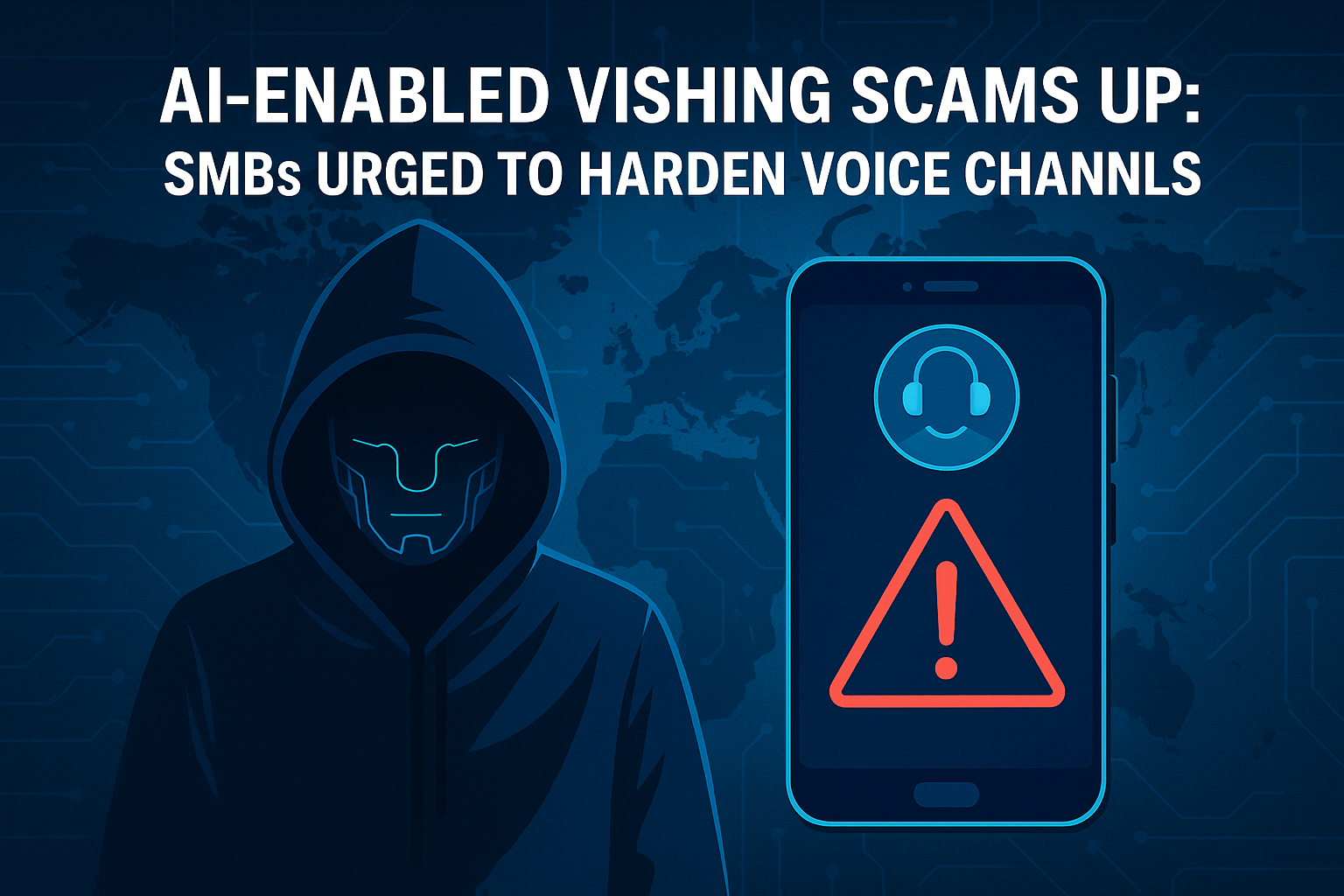
AI‑Enabled Vishing Scams Ramp Up: SMBs Urged to Harden Voice Channels
By InfoDefenders Editorial Team · July 30, 2025 · Latest News
A New Breed of Cyber Threat: AI-Generated Voice Fraud Hits SMBs
Cybercriminals have entered a new era—one where your voice can be weaponized against you.
In 2025, a surge of voice phishing (vishing) scams powered by generative AI is targeting small and mid-sized businesses (SMBs) around the world. These scams use AI voice cloning, deepfake audio, and automated scripts to impersonate trusted individuals—often executives, vendors, or clients.
And the consequences are already devastating.
“It sounded exactly like our CFO—same tone, same urgency. We wired the payment before anyone thought to double-check.”
— Anonymous IT Manager, manufacturing SMB
These aren’t random robocalls. They’re tailored attacks built using AI tools that are increasingly powerful, accessible, and dangerous.
What Is AI-Driven Vishing?
Voice phishing, or “vishing,” is the use of fraudulent phone calls to trick individuals into revealing confidential information, transferring funds, or providing access.
The 2025 twist? Generative AI models—like ElevenLabs, OpenVoice, and Voice.ai—can now:
-
Clone a person’s voice from just 10–30 seconds of audio.
-
Generate natural speech with realistic inflection, emotion, and timing.
-
Deliver real-time interaction with dynamic responses based on sentiment analysis or scripted branching.
Imagine receiving a call from someone who sounds exactly like your boss, CFO, or IT admin. The result? Deceptive urgency that overwhelms normal decision-making.
Why It’s Surging in 2025
Several trends are accelerating the rise of AI vishing:
-
Abundant public voice data: From webinars, podcasts, and YouTube to Zoom recordings, executives often leave digital voiceprints online.
-
Off-the-shelf tools: Cloning software is now inexpensive and requires no technical skill.
-
Work-from-anywhere culture: With fewer in-person interactions, trust is increasingly voice-based.
-
No verification norms: Most SMBs lack formal out-of-band validation procedures for phone-based requests.
AI attackers know this—and they’re exploiting it ruthlessly.
SMBs: High Exposure, Low Defenses
Unlike large enterprises, most SMBs don’t have:
-
A dedicated security team
-
Multi-channel verification for approvals
-
Anti-fraud voice analysis tools
-
Insurance policies that explicitly cover voice-based fraud
This makes them ideal targets. A single vishing attack can result in:
-
Wire fraud
-
Unauthorized access to email or HR systems
-
Exposure of customer data
-
Reputational damage
Real-World Cases That Should Alarm You
▶️ $25M Deepfake Zoom Call
In early 2024, attackers cloned the voices and faces of an entire executive team during a Zoom call with an unsuspecting finance employee. The result? A $25 million wire transfer.
AI Scam Bypasses Major Bank
In Australia, an SMB customer received a call from what appeared to be their bank. It used a cloned voice, spoofed caller ID, and convincing audio prompts to steal login credentials—draining the company’s account in under an hour.
SMB Executive Impersonation
A small HR firm in the U.S. reported a vishing call that mimicked their CEO’s voice, requesting payroll files and employee Social Security numbers. The voice was synthesized using clips from a company town hall on YouTube.
Common Tactics in AI Vishing Campaigns
Attackers blend multiple techniques for maximum deception:
| Technique | Description |
|---|---|
| Caller ID spoofing | Makes the call appear to come from a real contact. |
| Voice cloning | AI replicates tone, accent, and mannerisms of the target. |
| Urgent requests | “Wire this now or we miss the deadline.” |
| Insider lingo | Pulls from social media, email leaks, or public company material. |
| Real-time interaction | Some AIs adapt in real time using live audio models. |
How SMBs Can Defend Against AI Vishing
1. Implement Voice Verification Protocols
Create internal rules such as:
-
Dual confirmation for all financial or credential-based voice requests.
-
Verification of any sensitive phone requests via Slack, Teams, or direct email.
-
Optional: internal passphrases for sensitive communications.
2. Employee Education
Run training that:
-
Explains how AI voice cloning works.
-
Shares real-world attack recordings.
-
Rehearses simulated vishing attempts.
Quarterly phishing simulations are no longer enough—voice scenarios must be included.
3. Limit Audio Surface Area
Reduce your organization's “voiceprint” exposure:
-
Minimize posting internal Zoom recordings publicly.
-
Scrub executive voice clips from social platforms.
-
Limit podcasts or videos with leadership unless needed.
4. Secure Financial Workflows
-
Require dual approval on wire transfers or account changes.
-
Create friction: slow down sensitive transactions to enable verification.
-
Use out-of-band authentication—e.g. encrypted messaging apps.
5. Adopt Anti-Vishing Tech
Emerging tools include:
-
EchoGuard – detects audio patterns consistent with synthetic speech.
-
ASRJam – disrupts automated speech recognition bots.
-
Signal verification tools – use audio watermarking to confirm authenticity.
These tools aren’t yet mainstream—but early adopters are already testing them in security-conscious SMBs.
What Cyber Insurers Are Saying
Insurers are updating policies and requirements:
-
AI-driven vishing and deepfake fraud may not be covered unless explicit social engineering protections are in place.
-
To qualify, insurers now expect:
-
Documented anti-fraud protocols
-
MFA enforcement
-
Dual control on payments
-
If you don’t know what your cyber policy covers—ask now.
Final Thoughts: Ears Can Be Deceived
In 2025, AI voice cloning makes “hearing is believing” a dangerous assumption.
Vishing is no longer just a nuisance—it’s a high-impact threat vector that combines social engineering, automation, and psychological pressure.
Small businesses don’t need million-dollar security tools to defend themselves. But they do need:
-
Better awareness
-
Process discipline
-
Simple tools that verify identity and slow down fraud
AI is evolving rapidly. But so can your defenses.